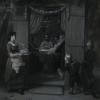1: Painting, Moritz Daniel Oppenheim's “Sukkot,” 1867.
German-Jewish painter Moritz Daniel Oppenheim (1800-1882) was perhaps the most famous Jewish artist of the nineteenth century, the first Jewish artist to connect with modern artistic currents and to receive classical training. He painted for and within non-Jewish German spheres, and yet did not convert to Christianity, and in his work he often depicted German Jews as they negotiated between German and traditionally Jewish cultures and practices.
This painting depicts a middle class Jewish family celebrating the festival of Sukkot in Frankfurt. The family sits in the sukkah for a meal while two blonde children, likely non-Jews, look on with curiosity. A maid outside the sukkah serves food to the family. The sukkah appears to be a modern domestic space, in which the family can maintain their bourgeois values and lifestyle, even as it is also an artifact of traditional Jewish observance.
Suggested Activity: Have your students discuss the following questions: What elements of traditional observance are present in this depiction? What elements are not present, and why do you think this is the case? Where do you see examples of the family’s prosperity in the painting? What role do the non-Jewish boys play in the painting? What conclusions do you think they are drawing about Jewish people and Jewish religious practices from what they see?
Teachers may also wish to refer to this lesson plan about the painting from the National Library of Israel.
Source: Moritz Daniel Oppenheim, "Sukkot (Feast of Tabernacles) (Das Laubhütten-Fest)," 1867. Oil on canvas. 25 7/16 × 22 in. The Jewish Museum, Gift of the Oscar and Regina Gruss Charitable and Educational Foundation, Inc.

